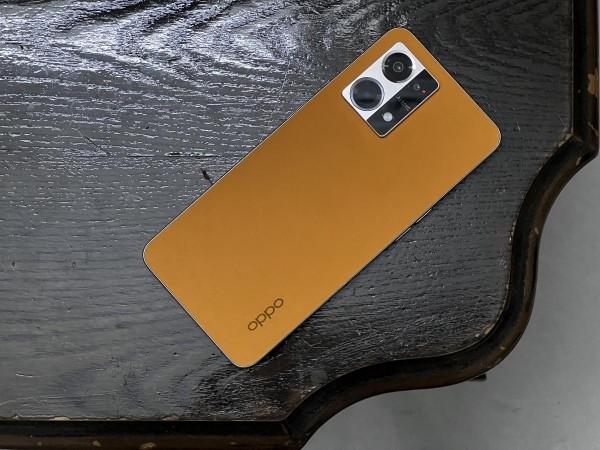Oppo F21 Pro was launched in April, expanding the company's popular F-series in India with a sub-Rs 25,000 offering. The effect of the Pro moniker is reflected in the camera and the design, but it is not without competition. 2022 has been quite an eventful year for mid-range smartphones and Oppo F21 Pro isn't merely an afterthought. It has left a mark, especially when offline consumers walk into a store and explore their options in the sub-25K price segment.
Oppo F21 Pro is marketed as a camera phone and there's a nice surprise in it. But the other aspects of the phone, such as the design, are to be desired. Let's look at the phone in more detail.
Key specs
- Display: 6.43-inch Full HD+ 90Hz AMOLED screen
- Main camera: 64MP+2MP(mono)+2MP(macro)
- Front camera: 16MP
- CPU: Snapdragon 695
- RAM: 8GB
- Storage: 128GB
- Battery: 4,500mAh with 30W SuperVOOC charging
Design
Oppo F-series has consistently stood out in terms of design and strike an appeal to the youth. The F21 Pro is no different. The bright orange-hued review unit sent to us has a peppy feel to it. There is a black colour option as well, which would be more suited to our taste, but the orange hue has the benefit of faux leather back and we're sold.

The phone gets a boxy design, giving flat aesthetics and a solid grip while holding. The matte silver chassis with a gold hue has chamfered edges on both sides connecting to the back and front panels. It has its own distinct presence, unlike many phones, which fuse the rear panel into the chassis. Matching the chassis is the camera module, which houses a triple camera sensor, only to get bigger rings. The third camera is positioned on the side along with the LED flash on a black glass panel. The camera module is slightly elevated from the back panel but doesn't seem out of place given the appealing silver and black combination. Oppo's logo takes its usual spot at the bottom left corner.

The most subtle, yet most stand-out part of the phone's design is its "Orbit light", which is a notification light around the camera sensor. It lights up when the phone's put on charge too.
The physical buttons can be found on the sides; power/lock on the right and volume on the left. The USB Type-C port and the speaker are placed at the bottom. What may seem unusual in 2022 is that the phone gets a 3.5mm jack, which is not a bad thing at all.

Overall, the F21 Pro looks great, has a premium feel and it is extremely light to handle.
Display
Oppo F21 Pro has a really good display, which is suited for multimedia consumption. The 6.4-inch Full HD+ panel is smooth with a 90Hz refresh rate, and the decision to go with AMOLED means blacks are deeper and colours are vibrant. We had no trouble using the phone in ambient lighting or under sunlight. But as we mentioned, it is suited for binge-watching more than gaming, as the latter can expose some pixels in high-GPU games.

The 90Hz refresh rate worked flawlessly and ensured a smooth delivery of animations most of the time. We had no trouble streaming multimedia on OTT and browsing social media apps. The display is suited for all tasks.

Camera
Oppo F21 Pro's camera setup is an interesting one. There are three cameras at the back - the primary one is 64MP, which is accompanied by two 2MP sensors. One of the two 2MP sensors is monochrome for your B&W shots and the other is Macro for your closeups. While the former is replicable by a software filter, there's a twist in the latter, which you need to experience first-hand.
The main sensor on the F21 Pro is quite capable. It shoots good quality images with balanced dynamic range, natural hues, and sharp details in good lighting. The inclusion of extra HD mode is no gimmick as it gives a 1080p resolution shot using Oppo's sub-pixel interpolation technique. It allowed us to capture more details and gave us the freedom to experiment with post-edits.

In low light, the camera seems to struggle a bit. With night mode, in extremely dark conditions, the camera picked up a lot of noise. When there's ambient lighting, the camera managed to click decent details and retain some natural tone for colours. There's an AI mode as well, which isn't surprising, but it worked to our advantage if the need for a dramatic image arose.
There's no ultra-wide mode due to the lack of a dedicated sensor, which we frankly think could have been included instead of the monochrome sensor. Interestingly enough, there's a microscopic mode, which lets you zoom into the tiniest objects at up to 30x and give an entirely new perspective to images. It has been the most fun mode although it required steady hands and well-lit scenes. In fact, the results came out really good and there was no way to compare the shots with the real deal as it was microscopic.
One thing's for sure, Oppo has truly given an innovative spin to an otherwise dull macro mode.
Oppo F21 Pro also gets a portrait mode and the bokeh is achieved through software rendition. There are some inaccuracies in clearly outlining the subject even in daylight shots. But the bokeh effect is nice and soft.
There are plenty of filters for you to explore but the one that stood out was the Bokeh Flare Portrait, which gave a nice DSLR-like effect. It works on selfie camera as well. But for selfies, we found the HDR works magic when shot against backlit backgrounds.
Check out some camera shots straight from F21 Pro's album:
Performance
Oppo F21 Pro is a mid-range device suited for mid-range tasks. It is powered by Snapdragon 680 processor, which can handle your day-to-day tasks with ease. But putting it under the pressure of graphics-intensive games like CoD: Mobile and Genshin Impact means setting for lower graphics for smoother gameplay.

In our daily usage, we noticed the apps would take some time, but that's compared to flagships. But system apps didn't cause any lags and multi-tasking with basic apps in the background was seamless.

But if you assess the F21 Pro by the number of features it has, it's going to impress you. The ColorOS 12 based on Android 12 lets you use air gestures for things like scrolling FB and YouTube. But it's more of a gimmick at this point except for using the air gesture to answer calls, which has real practical use.

If you do not mind the abundance of bloatware, there are some more features like a screen translator with 105 language support, and the level of customisation is nearly unmatched.

In conclusion, the F21 Pro is not a performance-driven phone but gets the job done while trying to impress you with some of its cool features.
Battery
Oppo F21 Pro is powered by a 4,500mAh battery, which is sufficient to sail through the day. We managed to get a full day's worth of use once the battery is charged to 100 percent. With heavy use, we would end up plugging in the phone in the evenings, but that required gaming or binge-watching TV shows on the phone. Otherwise, the phone will keep going for a whole day with around 7 hours of screen time on mixed usage.

The battery is also supported by fast charging and a 33W adaptor is included in the box. It's not the fastest one out there considering some rivals offer almost twice the charging speed at this price range. But it's not slow either. The phone can be fully charged in about 80 minutes. But you'll rarely notice the speed as a lagger.
Verdict
Oppo F21 Pro has many things going its way. From its peppy design to capable cameras and reliable battery to good display, the F21 Pro is built to impress. But it has its downsides, like the OS and average performance. What's worrisome is that the F21 Pro is not without competition. There are performance-driven handsets in the budget, but for someone who is looking for a good-looking phone for everyday use, Oppo F21 Pro could be the one.































